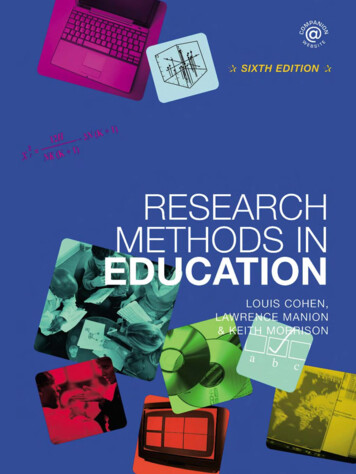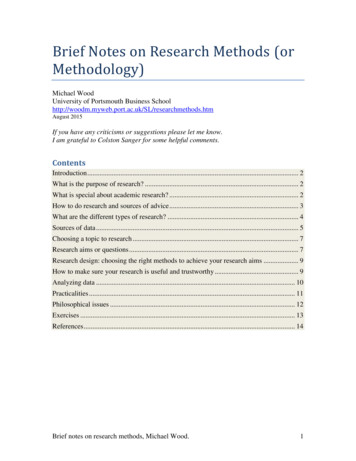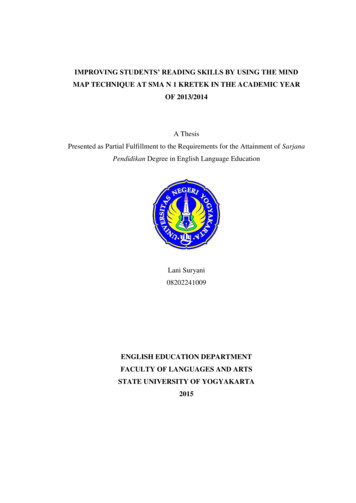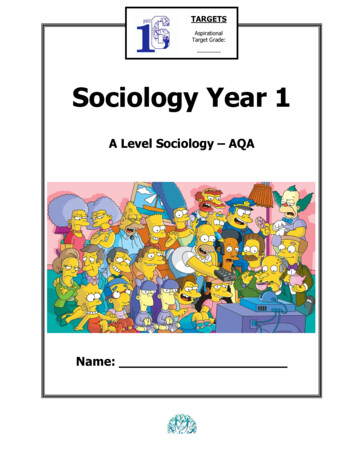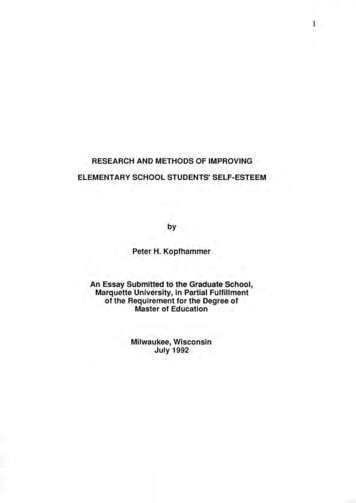
Transcription
1RESEARCH AND METHODS OF IMPROVINGELEMENTARY SCHOOL STUDENTS' SELF-ESTEEMbyPeter H. KopfhammerAn Essay Submitted to the Graduate School,Marquette University, in Partial Fulfillmentof the Requirement for the Degree ofMaster of EducationMilwaukee, WisconsinJuly 1992
3TABLE OF CONTENTSThe Importance of Self-esteem4Why Students Need Self-esteem6Definitions8Characteristics of Individuals with High and Low Self-esteem9Does Self-esteem Affect Achievement and Performance in School13Methods of Improving Students' Self-esteem17Summary33References35
4THE IMPORTANCE OF SELF-ESTEEMOne of the most vital and challenging roles of the school principal is tocreate an atmosphere of learning and trust. Since research indicates that a positiveatmosphere is essential for effective teaching and learning, the school principal canhelp develop a positive school climate by being enthusiastic, encouraging andoffering assistance to both teachers and students within the school.Many children today enter school with damaged self images. They attendschool while being exposed to unemployment, alcoholism and dysfunctional familyproblems which severely hamper their ability to learn. Children with low self-esteemdrop out of school, get into substance abuse, become pregnant as teenagers, feeldepressed, steal and cheat more, turn to alcohol, and use physical force more thanthose individuals with high self-esteem.Students with high self-regard achieve at higher levels. Successful studentsfeel better and take more risks than low self-esteem students.Successfulexperiences help students feel good about themselves and they then take more anddifferent risks. The more students risk and feel good about themselves, the moreesteem rises and the greater the achievement.Self-esteem does not suddenly appear at age five, ten or twenty-five.Psychologists believe self-esteem begins to develop in infancy. They also believethat children between the ages of twelve and thirteen have the hardest timedeveloping and maintaining a positive self-image.Three groups of individuals, parents, teachers and peers, provide positiveand negative feedback to children. Parents provide the primary source of self-worth.The second most powerful influence comes from teachers, and peers provide thethird most powerful influence on children's self-worth. As a result, children usually
5perceive themselves from the perspective of others and compare themselves toothers.
6WHY STUDENTS NEED SELF-ESTEEMCurrent research indicates self-esteem is a key factor in improving behaviorand the academic achievement rates of students. Teachers intuitively know thatwhen children feel better about themselves they do better in school. G.B. Gillmanstated, "The development of a positive self-concept is a necessary prerequisite toacademic achievement and should be a major objective of every school that isconcerned with the development of productive citizens," (Battle, 1982, p.61).Charles Lipton offered the following remarks about the relationship of self-esteemand achievement. "The roots of desire to learn are deep and multibranched. Thedevelopment of a self-worth and self value is one of the most important andsignificant of these branches. To know oneself and to value oneself contributesmightily to the development of an able learner, a curious learner and a maturelearner," (Battle, 1982, p.62).Some students feel school is a place where security, worthiness,significance and purpose are seldom found. Schools sometimes foster students intomaking negative judgments about their self-worth and these negative judgmentsoften limit and shape their beliefs about themselves for the rest of their lives.Self-esteem researchers believe that positive self-esteem building activitiesneed to become an integral part of the classroom and school curriculum. Increasinga student's motivation, responsibility and achievement level can be enhanced whenthe student has a positive image of himself.Self-esteem can be changed andlearned regardless of the person's age, and ifit is learned, it can be taught. HenryAdams summarized a teacher's role with students when he said, "a teacher affectseternity, he or she can never tell where their influence stops," (Borba, 1986, p.1).The importance of building positive self-esteem was stated in The Finalreport of the California Task Force to Promote Self-Esteem and Personal and Social
7Responsibility. "Schools that feature self-esteem as a clearly stated component oftheir goals, policies and practices are more successful academically as well as indeveloping healthy self-esteem," (Battle, 1982, p.76).
8DEFINITIONSA wise man once said, "the most important thing a parent can give a child,more important than anything material is a sense of self confidence," (Berne, 1985,p.63).Jim Beame, author of the book "Enhancing Self-Esteem, Kids Come First"defined self-esteem as "the degree to which I am satisfied with myself and my selfconcept," (Beame, 1986, p.89). Nathan Branden in his book "The Psychology ofSelf-Esteem" states that self-esteem refers to "the perception the individualpossesses of his or her own worth," (Krupp, 1991, p.62). An individual's perceptionof self-esteem develops gradually and becomes more differentiated as he or shematures and interacts with significant others. Michele Borba in her book "ImprovingStudent Achievement and Behavior Through Building Self-Esteem" defines selfesteem as "the quiet confidence one has in oneself," (Borba, 1986, p.3). CaliforniaTask Force to Promote Self-Esteem and Social Responsibility developed thefollowing statement in 1989."Self-esteem is appreciating my own worth andimportance, and having the character to be accountable for myself, and to actresponsibly towards others," (Krupp, 1991, p.63). Andrea Brennan, a professor atSaint Francis Xavier University, states "self-esteem is the evaluation which theindividual makes and customarily maintains with regard to himself - it expresses anattitude of approval or disapproval and indicates the extent to which an individualbelieves himself to be capable, significant, successful and worthy," (Yoder andProcter, 1988, p.112).
9CHARACTERISTICS OF INDIVIDUALS WITHHIGH AND LOW SELF-ESTEEMThe sense of self-value one possesses can vary rather radically. Difficultand different times, events, people and experiences can influence the degree of selfworth a person has at that moment. Individuals who possess a positive self-conceptgenerally tend to differ from those individuals who possess negative self-concepts bya set of characteristics. S. Coopersmith, in his book Antecedents of Self-Esteem,listed seven characteristics normally displayed by students with a high self-value,(Battle, 1982, p.41).I."ACT INDEPENDENTLY." Individuals will make choices and decisionsabout such issues as time usage, money, jobs and they will seek friendsand entertainment on their own.II."ASSUME RESPONSIBILITY." They will act promptly and confidently andwill sometimes assume responsibility for obvious chores or do so withoutbeing asked.III."BEPROUDOFACCOMPLISHMENTS."Students will acceptacknowledgment of achievements with pleasure and even complimentthemselves about their acknowledgments.IV."APPROACH NEW CHALLENGES WITH ENTHUSIASM." Unfamiliarjobs, new learning and activities will be interesting to students and they willinvolve themselves confidently in the new act.
10V."EXHIBIT A BROAD RANGE OF EMOTIONS AND FEELINGS." Thestudent will be able to laugh, giggle, shout, cry and express affectionspontaneously, and in general, move through various emotions without selfconsciousness.VI."TOLERATE FRUSTRATIONS WELL." This individual will be able to meetfrustrations with various responses such as waiting through it, laughing athimself, speaking up firmly, and can talk about what frustrates him.VII."FEEL CAPABLE OF INFLUENCING OTHERS."Students will beconfident of their impression and effect on family members, friends andeven authorities, such as teachers, police and their bosses.Persons with high self-esteem will express their feelings about themselves andothers in many subtle ways; smile, return eye contact, stand straight, and extendtheir hand in greeting. When an individual has a positive self-concept image, thatperson feels more capable and thinks confidently, thus tending to behave insuccessful ways which further increases a sense of self-worth.S. Coopersmith also listed a set of eight characteristics displayed by studentswith low self-value, (Battie, 1982, p.42). Students with low self-worth can have manyof the following qualities.An individual with low self-worth usually has a negative self-value and a lowself-image. These individuals tend to receive excessive criticism, punishment, andthe feeling of disappointment from the people around them. Also, they have a strongbelief that they are powerless to attain what they want from life. People with a low orpoor self-image often become withdrawn, depressed and angry toward life and view
11themselves as not being valuable or lovable. Low self-image individuals have astrong conviction that whatever they do will be wrong and they look for ways to fail.Students with low self-value can have many of the qualities listed below.I."DEMEAN THEIR OWN TALENTS." They will say, "I can't do this or that," "Idon't know how," "I can never learn that."II."FEEL THAT OTHERS DON'T VALUE THEM." They will feel unsure, ordownright negative about their parents or friends support and affection.III."FEEL POWERLESS." Lack of confidence or even helplessness will pervademany of their attitudes and actions.They will not deal forcefully withchallenges or problems.IV."BE EASILY INFLUENCED BY OTHERS." Their ideas and behavior will shiftfrequently, according to whom they are spending time with. Furthermore, theywill be frequently manipulated by strong personalities.V."EXPRESS A NARROW RANGE OF EMOTIONS AND FEELINGS." Someof the emotional characteristics displayed will be nonchalance, toughness,hysteria and sulking which can be expressed repetitively.Parents and/oradults can predict which responses can be expected for any given situation.VI."AVOID SITUATIONS THAT PROVOKE ANXIETY." The tolerance for stress,especially fear, anger or chaos provoking circumstances will be low.
12VII."BECOME DEFENSIVE AND EASILY FRUSTRATED." They will be "thinskinned," unable to accept criticism or unexpected demands and have excusesfor why they couldn't perform.VIII. "BLAME OTHERS FOR HIS OR HER OWN WEAKNESSES."They willrarely admit to mistakes or weaknesses and frequently name someone else orunfortunate events as the cause of their difficulties.
13DOES SELF-ESTEEM AFFECT ACHIEVEMENT ANDPERFORMANCE IN SCHOOL?.Considerable evidence has been documented to indicate that a relationshipexists between increased self-esteem and academic achievement.Gail Dusa,(Canfield, 1990, p.48), and her associates at Silver Creek High School in San Jose,California conducted a four year study of self-esteem. The freshman class of theschool was divided into two groups.The experimental group of ninety-threestudents was taught by teachers who adhered to three operating principles. First, allstudents were treated with unconditional positive regard.Second, teachers andstudents were encouraged to be all they could be. Third, teachers encouraged allstudents to set and achieve goals. The last condition was that the group participatein a forty minute activity every other Friday throughout their freshman year to buildself-esteem. The control group of students, also ninety-three in number, received notreatment, but was monitored along with the self-esteem group for four years. At theend of the four years, G. Dusa's findings were:1.2.3.4.5.Self Esteem GroupControl Group116Days of absenteeism per pupilper semester.Percentage of students who completed90% or more of their homework.75%25%Percentage of students who participatedin 20 or more extracurricular activities.25%2%Percentage of class offices held by groupsbetween freshman and senior years.75%0%Percentage of students who graduatedfrom high school83%50%
14Dusa concluded that to raise the self-esteem of students, you must first startwith the school staff.The main way students learn is through modeling andimitation. If teachers have low self-esteem, they are likely to pass it on to theirstudents.Teachers and the support staff of the school need preservice andinservice training on self-esteem before students' self-esteem can be enhanced.Helen R. Hadley, an elementary school counselor, conducted a research studyto establish the impact that self-esteem has on academic growth. In her study shecited the work of E.R. Gerler, whose research study found dramatic improvements inreading scores after students participated in a self-esteem curriculum. Also Hadleycited the research of H.W. Marsh which documented self-esteem as a responsibleagent for the general academic achievement and growth.Hadley conducted her own study with one hundred-sixty-five male and femalestudents in the second grade from one elementary school during the school year of1984 through 1985. Group tests before and after intervention were administeredusing the Piers-Harris Children's Self Concept Scale to measure self-esteem. Thedata from the Spring 1984 and Spring 1985 Stanford Achievement Test readingscores were used to measure improvement in reading achievement for theexperimental and control groups.Intervention consisted of a twelve week self-esteem program appropriate forsecond grade students.This self-esteem curriculum was presented to threeclassrooms for one half hour a week for twelve weeks before the second SAT wasadministered in 1985. The remaining four classrooms did not receive the selfesteem program and were identified as the control group.The pre and post test SAT scores were analyzed and revealed a statisticallysignificant increase in reading achievement by the experimental group compared tothe control group. The score increases by the experimental group on listeningcomprehension were double that of the control group.
15Several implications arise from Hadley's study and she used the research dataof D.N. Aspy, R.N. Roebuck and A. Brennan to support and validate her researchconclusions. They found that students can be expected to perform better when theyare reasonably happy and confident. D.N. Aspy and R.N. Roebuck in 1982 reportedthat children with high self-esteem have improved attendance, cause less vandalismand have fewer disruptive incidents than those students with low self-esteem.Finally, Hadley believes that schools need to educate the "whole child," the cognitiveas well as the affective domain.Andrea Brennan conducted a research study to support the view that socialinteraction and participation influence the students' self-value.Brennan sent out a questionnaire to a random sample of two-hundred and twofemale students in five area high schools. Four subdivisions of self-esteem wereidentified: Evaluation of Group Interaction, Leadership Qualities, Self Satisfactionand Self Fulfillment.scores.The measures were established by adding the individualEach question consisted of a nine point scale ranging from strongdisagreement (1) to strong agreement (9). After analyzing the questionnaires, theresults agreed with the hypothesis that through involvement with others, learningabout others and self, increasing self-confidence and defining one's role in society, aperson establishes positive self-regard.Many factors help determine and develop an individual's self-esteem.Socioeconomic status, height, weight, grade point average in school and churchattendance were found to influence self-esteem.Self-esteem, especially a student's, is dependent on many variables;participation is one of these . A person enters an activity with a certain level of selfesteem. If the activity is a positive experience, esteem is increased. This in turnmay lead to greater participation in the activity or in new ones. Past participation isthe foundation for present participation and serves as a guide to future endeavors.
16It is hypothesized by many investigators that increased student participationleads to increased self-esteem .The data from the research supports thishypothesis. Student participation increases perceived self-value such that the peoplenot only feel comfortable with others, but with themselves as well. As persons meetothers, initiate and maintain peer relationships, they improve self-esteem.Participating in a variety of experiences also serves to enhance self-image.
17METHODS OF IMPROVING STUDENTS' SELF-ESTEEMTeachers know that when children feel better about themselves, they do betterin school. The simple fact is that "many children today are not receiving enoughpositive, nurturing attention from adults either at home or at school ," (Elkind, 1990,p.194). Child psychologist James P. Comer has stated, "what parents say to andabout our children and how we say it has an impact on how children feel aboutthemselves.Parents and teachers can encourage self-esteem through praise,guidance and appropriate constructive criticism," (Comer, 1987, p.44) . David Elkind,a clinical psycholog ist, believes that "parents need to let children know perfection isnot the norm in real life. Parents need to tell their children of the many stupid thingsthey have done in their past and have overcome," (Elkind, 1990, p.195).The challenge facing schools is great, but there are day to day thingseducators can do to increase children's self-esteem and, in so doing, improve astudent's prospects for success. Following are four plans and ideas on self-esteemwhich are explained.I.Jack Canfield is the president of Self-Esteem Seminars located in Culver City,California. He believes in a ten step model to help students increase their selfesteem and become what he believes are "winners in life."Step 1. "Assume an attitude of 100% responsibility." Canfield introduces thefollowing formula: E (events) R (your response to them) 0(outcome).When students do not get the outcomes they want, the author urges them notto blame external events and other people, but to take responsibility forchanging their responses. He emphasizes that we are responsible for ourbehavioral responses and that we have choices to make.
18Step 2. "Focus on the positive." In order to feel successful, you have to haveexperienced success. Many students, because they feel they have never doneanything successful , need to be coached about identifying successfulaccomplishments in their lives that they did not recognize before.Manystudents equate "success" with winning a medal or getting rich . Adults andteachers need to help students remember their accomplishments, not theirfailures in life.Step 3."Learn to monitor your self talk."thoughts about ourselves per day.Each of us has about 50,000Students and adults need to learn toreplace negative thoughts with positive self talk. "I can learn that," I am smart,"and "I accept myself" are examples of positive self talk. Jean Yoder andWilliam Proctor in their article The Self Confident Child state, "a person shouldemphasize the can do language and adults should encourage children toemphasize the positive rather than the negative in their own conversations,"(Yoder and Proctor, 1988, p.114).Step 4. "Use support groups in the classroom." For some students, it ispossible for them to come to school for a whole day and never be in the centerof positive attention. Sharing ideas, talks and the use of support groups helpstudents overcome the feeling of alienation and rejection. Nancy Samalin, theauthor of the article Children and Creativity, believes talking groups "is aneffective way of learning to respond in a caring way, is the first and necessarystep in helping children feel competent," (Samalin, 1987, p.76) . WilliamGlasser in his book "Quality Schools" believes that teachers and administratorsneed to spend two minutes per day listening to the students talk about theirlives without the other students and adults being judgmental. "When students
19talk, they learn that it is a positive healing experience to talk about theirfeelings and they become bonded to their fellow students," (Glasser, 1988,p.17).Step 5. "Identify your strengths and resources." A vital part of improving selfesteem is the broadened awareness of one's strengths and resources. Anexample of this technique is to have students in their support groups writedown and tell each other what they see as their positive qualities andstrengths. The child needs to be realistic as well as being positive. It is veryimportant to help students note those areas that need more development ifthey are to achieve their goals. Children need to choose words or phrases thatbuild up and encourage rather than using words that tear down their selfesteem.Raymond Wlodkowski, the author of the book "Motivation andTeaching," states "the greatest evil that can befall man is that he should talk orcome to think ill of himself," (Wlodkowski, 1978, p.48).Step 6. "Clarify your vision." Without a clear vision, there is no motivation.Creativity is generated by doing what one most wants to do and is enhancedby taking the risk to live how one most desires to live.Nancy Samalin'sphilosophy is "learning is driven most quickly by the pursuit of what mostinterests the individual," (Samalin, 1987, p.74).Step 7. "Set goals and objectives." Students need to be taught how to setmeasurable goals and objectives for themselves, family, school andcommunity. The students share their goals with the rest of the class, supportone another as they work toward them , and celebrate any completed goals.Many students set unrealistic goals for themselves and feel rejected and hurt
20when they do not meet their high goals. When students feel important and thegoals they set are attainable, they will work harder and longer to reach thegoals. Real learning occurs when a student develops a sense of mastery overthe material.Step 8. "Use visualization." When we hold a clear vision of our goals, as ifthey were already achieved, the action releases creativity, increasesmotivation and alters our perceptions of ourselves and our environment.Students need to spend five minutes per day visualizing each of their goals asif it were already achieved.Step 9. "Take action." To be successful, you yourself have to "do the doing."The author suggests constantly working with students to stretch into more andmore action steps, doing things they previously did not think possible. Manystudents believe that difficult work is out of the question and do not attempt todo the work. Students need challenge in their classes. Challenging tasks canand should be invigorating and energizing . William Glasser in his article .s.sillImportance Boosts Learning, lists four ways students and teachers can takeaction together. First, students and teachers need to plan together the goals ofeach chapter and unit. He firmly believes that choice equals responsibility.Second, students check their own progress and record their progress. Thismethod helps the students see their own growth and progress. Third, studentsneed to work together. In traditional classrooms, students are told to workalone and not to talk to other students. Glasser believes that when studentstalk and listen to each other, the learning and social support increases for eachchild in the group. "The more students talk the more they learn," is Glasser'sphilosophy, (Glasser, 1988, p.19). Fourth, encourage students by respecting a
21student as a person. Teachers need to trust and believe in students and theirability to learn.Step 10. "Respond to feedback and persevere." Students need to be inspiredwith stories of people like themselves who have gone on to do great things,often by working against the odds. Students need to be shown how mistakescan be used to grow, to use positive and negative feedback to their advantageand to persevere until they accomplish their goals. Parents, teachers andadults need to listen to children and what they are saying. When talking with achild, it is important to be a good listener, otherwise we may miss the chanceto discover what the child's message is.Jack Canfield believes his ten step model will increase a child's self-esteemand achievement rate when implemented by parents, teachers andadministrators, (Canfield, 1990, pp. 48-50).II.Patricia H. Berne is a clinical psychologist and co-author of the book "BuildingSelf-Esteem in Children." She believes that "self-esteem is as important tochildren as the air they breathe," (Berne, 1985, p.63). Berne believes thatmany children in our society lack self-esteem and many adults do notrecognize the need for self-esteem. Children need to realize what adults,peers and other children appreciate about them in order to feel self-worth. Asother people respect and value us, we develop the capacity for self-worth.Children need to have success in their lives and to be shown over and overthat they are being held in a positive manner by the people in their world.When children feel good about themselves, they begin to see themselves as
22worthy of respect and love from others. P.H. Berne believes in seven methodsteachers and parents can use to improve a child's self-esteem.Berne's first step in building self-esteem is "establishing success for theindividual." To build a sense of success, create situations where failure for theindividual is unlikely. Structure large tasks into a series of easy steps so that asense of failure does not stop the child from wanting to try again. She states,"new situations should be comfortable, fun and interesting as possible withstructured situations planned for a specific time with a successful outcomeassured for each child," (Berne 1985, p. 63). Educators and adults need to bealert to what causes fear, embarrassment and hesitancy in each child. Ratherthan pushing them, teachers need to follow the children's lead. Often takingthe route of a child's own interests leads to successful learning. Successbuilds self-esteem, especially when the chain of success remains continuousand unbroken.The second method of developing self-esteem is to "state the positive."Typical student work receives the words "right," "wrong," "bad," "good," "OK"and "worse." Children are often not reinforced for what they do correctly, butevaluated in light of their failures. Two methods of marking students' paperspositively are: first, putting the number of correct answers on the top of a testor paper instead of the number of wrong responses.Second, the correctanswers on an assignment or test should be marked instead of the wronganswers. Teachers can use these two methods to help foster the positiverather than the negative grading methods in schools. Stating the positive onstudent work draws the students' actions to their strengths, not theirweaknesses. Acknowledging the positive responses nurtures success.
23The third of Berne's methods for improving self-esteem ,is to "capitalize onsuccess," When interest has produced success, it is possible to use theexperience to create new successes and to expand the child's interests. Achild's success stories need to be shared with parents and other students.Sending home positive notes to a parent is an example of building successbetween the child and the teacher. Reading the note to the child before it issent home to the parents helps develop a high degree of trust and honestybetween the child and the teacher. Children will feel success is possible if youcan help them build a history of successes.The fourth manner of establishing self-esteem is to "watch for growth sparks."Children with low self-esteem tend to believe they cannot learn or successfullyrelate to other people. Often these children will not relate or learn successfullyuntil a spark of interest is shown towards them. Many students defined asbeing "learning disabled" often have learned and use the negative mentalblock of "I can't do it" rather than actually having a low ability level. Glasser'sphilosophy is "All students need to believe that they can learn material inschool," (Glasser, 1988, p.16).The fifth suggestion for building self-esteem is "value and acknowledge ."Teachers and parents need to keep a portfolio of the child's work. Noting thedates the children did their work shows them their development and developsa sense of pride. Parents can attach their child's work to a refrigerator doorand/or cabinets. These surfaces provide the visible history of a child's growthand accomplishments. By preserving children's work, it communicates themessage to them that their work is worth saving.Parents and especiallyteachers need to understand that the display of work is not just for "A" work,
24but for any work that shows accomplishment. Evidence of success that isvisible and tangible has a strong positive effect on a child's self-esteem.The sixth method of developing positive self-esteem is to "keep expectationsrealistic." Expectations can evoke energy and excitement when shared openlyand fairly. Sometimes teachers presume that their way is the only way to do atask. Children need the opportunity to explore, recreate or redesign a piece ofwork. The teacher's "only way" method, which says to children, "You can onlylearn it the way I think you should," destroys confidence and creativity. Forcedestroys a child's confidence, creative ability and excitement.Within thestructure needed by children, teachers need to let students explore and createtheir dreams and goals. Love by teachers allows the human genius to begin togrow.Berne's seventh and last method of fostering self-esteem is "don't be boring."Some things that need to be done in life will always be tedious. The challengefacing a teacher is to find new and creative ways to relieve the boredom. Ateacher can acknowledge when a task is frustrating or boring. When feelingsare recognized, children often become less resistan
Self-Esteem" states that self-esteem refers to "the perception the individual possesses of his or her own worth," (Krupp, 1991, p.62). An individual's perception of self-esteem develops gradually and becomes more differentiated as he or she matures and interacts with significant othe

